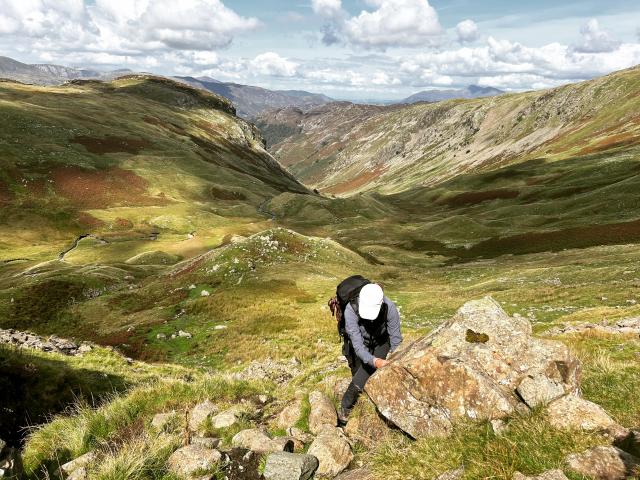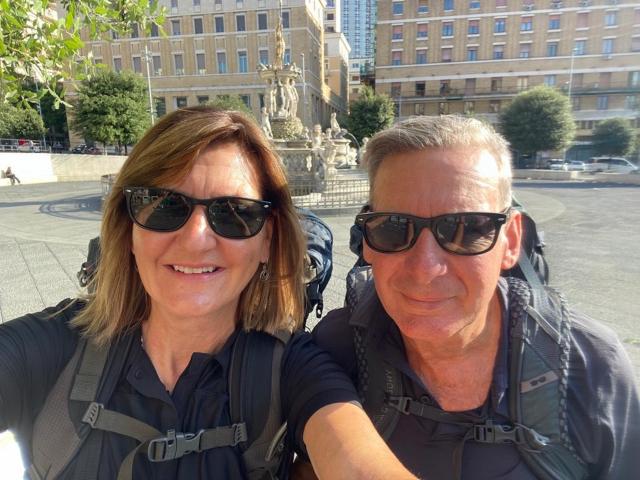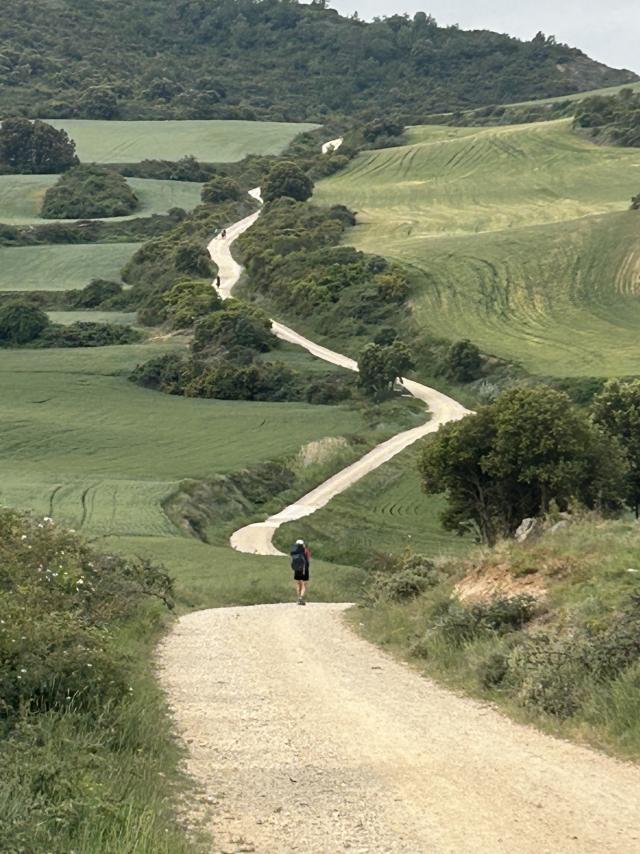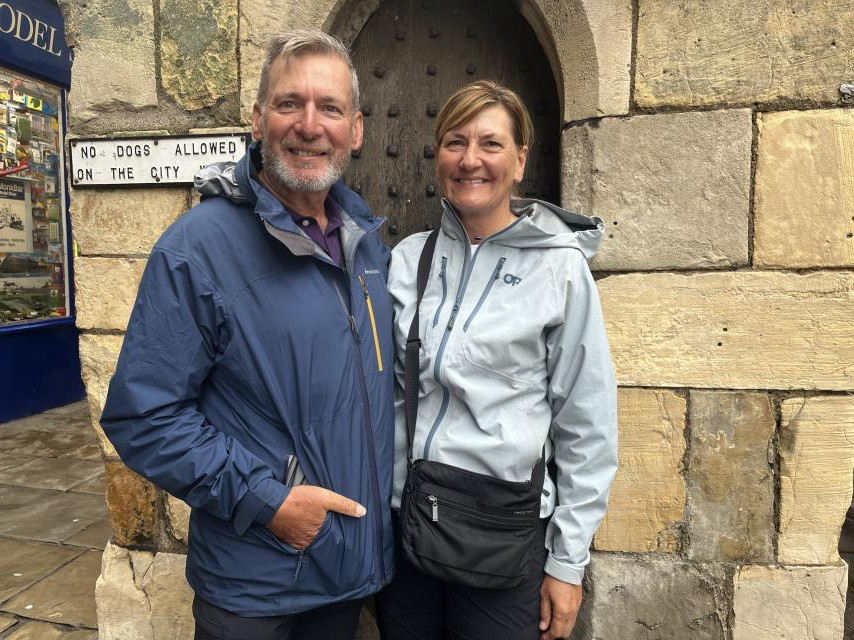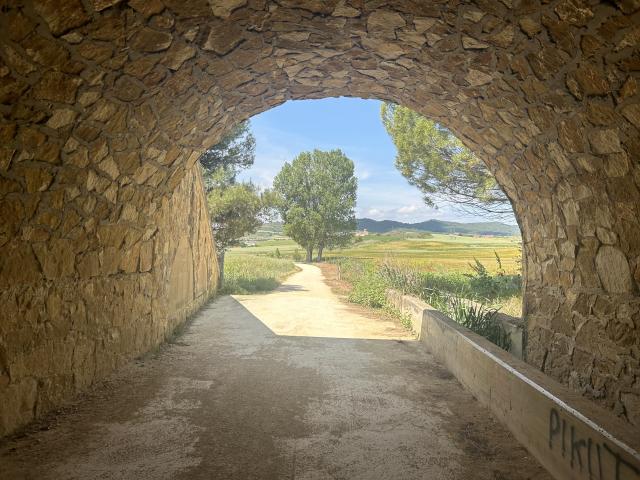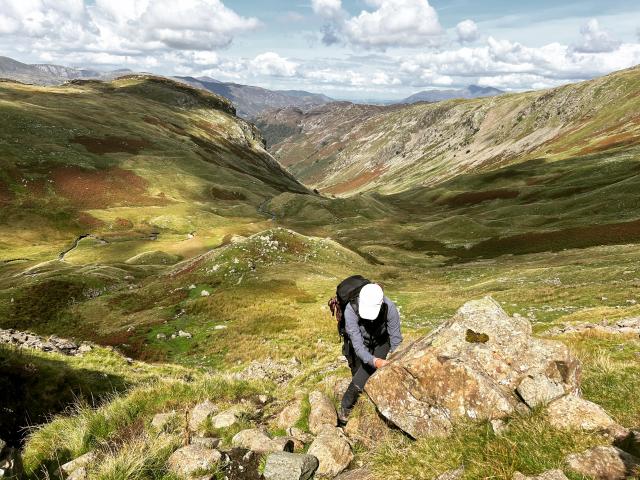
We all know that a short walk in the wild is good for the soul, but Noosaville partners and fellow health professionals Jane Campbell and Graeme Conway have taken that wisdom a few steps (perhaps a few million steps) further, completing the famous Camino de Santiago pilgrim trail across northern Spain (800 kilometres in six weeks) and the challenging Wainwright Coast to Coast trek across northern England (313 kilometres in two weeks) over the past four months.
Variations on the medieval pilgrims’ journey to the Cathedral of Santiago de Compostela in Galicia at the northwest tip of Spain have become increasingly popular in recent decades, with walkers of all abilities doing the entire walk from the delightful French Pyrenees border village of St Jean Pied de Port or picking off the low-hanging fruit in short treks of a couple of weeks or less.
The lesser known Coast to Coast was devised by rambler and environmentalist Alfred Wainwright and set out in his 1973 book A Coast to Coast Walk. Usually walked west to east, the route starts at St Bees on the Irish Sea and ends at Robin Hood’s Bay on the North Sea. In between are the three National Parks of the Lake District, the Yorkshire Dales and the North York Moors, spectacular scenery and a lot of hard yakka.
Our former neighbours Scottish-born Jane and keen surfer Graeme were no strangers to strenuous outdoors activities, and had actually sampled the Camino lifestyle, completing the much shorter Camino Portugues Coastal prior to the Covid pandemic, but this was a more considered undertaking for the sexagenarian couple. Says Jane: “I’m calling it Jane’s third act.” Graeme: “I’m calling it a sabbatical.”
We caught up with our friends over a couple of bottles of wine in the historic walled city of York last week, just a few days after their completion of the Coast to Coast, and were captivated by their stories, photos and Insta posts of a life-changing (and ongoing) adventure.
Phil: What made you do this? Was it a Covid thing?
Graeme: More that we had both been looking after our aged parents for a number of years and all of them had passed away, most recently my dad, just short of 100. Not having children of our own but having friends and family dotted around the world, we thought this was an opportunity to hit the pause button on work and focus on some Jane and Graeme time, doing the things we like doing in different parts of the world. We both like hiking and we like doing it together, whereas I like surfing but Jane’s not really into it. We went to New Zealand for six weeks last summer and did some challenging day hikes and just loved it, so that was a springboard to doing what we’re doing in Europe.
Jane: Then we thought that if we went for an extended period we’d be able to do and see other things, not just hiking all the time. Fortunately, while we were considering the possibilities a friend from Sydney came to visit and said she’d like to rent our house, so we took off at the end of May.
Graeme: We downsized everything, taking months to pack up the house and get used to the idea of having fewer material possessions. We left with backpacks weighting 12kg, which was everything for a year. The first day of the Camino as we started hiking over the Pyrenees the weather was horrendous, freezing cold with sleet, mist and fog. You really couldn’t see more than a couple of metres ahead. It was the toughest day we had. There was no fire but it was a baptism of every other element you could think of. We really wondered whether we were going to be able to do this, but the weather got better and then it got hot. And we started to be inspired by the history we saw all around us, the castles and churches and so on.
Jane: The Portuguese Camino gave us a taste of it, but that was quite different because we’d just decide how far we were going to walk each day and book a place to stay on our phones. This time we started looking in February to book accommodation for May and all we could see was fully booked! So we had to adjust the walk according to where accommodation was available. We had the option to stay at hostals but chose to go with mid-range hotels but we had to research a lot to find them. Finding somewhere to eat at night was a bit random. In some small villages you didn’t have a choice.
Phil: What are the memories of events and people you met along the way that have stayed with you?
Graeme: People do the Camino for all sorts of reasons but a lot of people do it for religious or spiritual reasons. Some treat it as an extreme event and run or cycle it as fast as they can. Then there’s a mix of cultural reasons, to look at beautiful old buildings for one, gastronomy for another. For us I guess it was a mixed bag of all of those things.
Jane: There are so many memories but if you just pick a few out, I think it begins with the journey, the walk itself, but the people you meet provide the substance to overlay that, the most random meetings with people you could ever have. Someone starts walking beside you and you just start talking, or if there’s no strong connection you just say, “Bon Camino” and separate. And that’s absolutely fine too. There are no expectations of how you’re supposed to interact, and that’s wonderful. It’s a cliché to say it, but some people bond and become a Camino family. They check on each other along the way and remain in contact after it’s over.
I’m not a religious person but I did find that some of the churches we passed were wonderful to go in and meditate or just rest, so peaceful and cool when it’s hot outside. Because we weren’t staying at the hostals we didn’t participate in all the group activities they offer, but one night we did go to a church to hear the singing nuns. We all sat in this little room, people from all over the world, and we each said a few words about why we were doing the Camino, and then we all sang together before eating a simple dinner with the nuns. It was a joyous thing but also you could see the vulnerabilities of some people. Perhaps people who had lost a friend or family member and there were doing the walk for them, so there was a lot of emotion.
Graeme: In another town we heard that there was a convent where the nuns bake great biscuits that you could buy. So we walked out there and came to a big old convent with a high wall and a gate just slightly ajar. We went inside and there was a little robot lawnmower doing the lawns, which seemed quite incongruous. There was a big closed door but I pressed a button and a voice came from behind saying hello. I said we’d come to see the nuns and she said you can’t. I said we were hoping to have a cup of tea and a biscuit with them. She said no, however we could walk around the side and look at the chapel, which was very dark and facing inwards with steel bars everywhere like a prison. The nuns were sitting there in the darkness and I realised it was a cloistered order. Quite a change from the singing nuns.
Phil: Was there an element of healing in your walk, even if you didn’t set out that way?
Jane: For me I think there was a sense of letting go after what we’d been through with family dying, the stress of decluttering our lives and other things, and by the time we left on the journey we were both exhausted. When we started the walk I felt hyper-charged, but once we got into the rhythm of it, the walk was quite cathartic. It was quite a beautiful thing to slowly realise, I don’t need to be anywhere else at this moment in time, and all we need to think about is what we’re going to eat for breakfast, lunch and dinner. The thing you can’t buy is time, and having lots of time allows you to shape it. It becomes a valuable commodity.
Graeme: So you’re walking along in the heat, wearing shorts and a tee, and there are no toilets out there so you just wander off the track a bit and find a bush. But there’s a lot of paspalum in the longer grass and with that and the heat I developed a quite severe rash on one of my legs. My calf doubled in size overnight and I could hardly walk on it. We video-called a medic mate in England and he had a look at it and prescribed antibiotics and anti-inflammatories and told me how to treat it. The next day I wasn’t feeling well enough to walk but Jane took off and I was going to get a bus. But I started walking around the local area looking for inspiration to walk the trail, and my inspiration came from my dad who had been in New Guinea in World War II and I’d listened to all his stories about walking through the jungle for days. So I started walking rather than catching the bus. I was limping but I just kept going and I suddenly felt this great wave of inspiration. I was walking on my own and I began to feel quite emotional, crying and talking to my dad. The further I worked the stronger I got. Jane rang me at some point and was quite surprised but for me it was a great moment of overcoming my pain in several ways.
Towards the end of that day another guy came limping towards me. He was English so we struck up a conversation and I suggested we limp along together. It turned out he’d been an advisor on cyber-security to the British and Australian governments. People are very open on the Camino. They’re willing to share so much with you, and with my professional perspective as a psychotherapist, they seemed willing to share even more with me. On several occasions I found myself in quasi-therapy sessions, which I really enjoyed.
Phil: So you had six weeks on the Camino, a bit of a break touring around the hotspots of southern Europe and then you’re walking again. Was it hard to get back into it?
Jane: Well, we had about six weeks off between them, so we were pretty ready.
Graeme: We were in Italy during a heat wave which was challenging too, but when we took on the Coast to Coast I think we were a bit naïve, feeling if we’d done 800km on the Camino we were ready for anything. But from day one it was much more demanding than we’d expected.
Jane: It was more hilly and more challenging than we expected, there were some very narrow sections of trail along cliff faces and I get anxious about heights.
Graeme: We’re talking about putting one foot in front of the other along a sheer drop-off with me telling Jane, don’t look down! We took the high route which in retrospect was a mistake. Also there’s a huge difference between navigating the Camino where you just follow the big yellow arrows and the Coast to Coast where until recently you really had to know how to navigate and read a compass. Alfred Wainwright wanted to give people choices for different weather conditions, which makes it much more difficult. You need to be checking your route at least every 20 minutes.
Jane: After the mountains it got much better, very beautiful, but there were other challenges like bogs where you could easily lose a boot.
Phil: Were the people you met on the Coast to Coast different from the Camino?
Graeme: They seemed to be at first but what was revealed was that everyone has a story if you take the time to listen, and that’s what we did, from kids who had nothing and were trying to find themselves to people at the high end of the social spectrum.
Jane: There were a lot of young guys doing what they call wild camping, where they just walk and walk and pitch their tents when it gets dark. They get through a lot of kilometres a day but it means they have to camp anywhere and it’s often boggy and wet and very rough.
Phil: What were the takeaways when you sat down at the end at Robin Hood Bay and analysed what the experiences had given you?
Jane: Well, we talked about that a lot while we were still walking, and Graeme said, we’re not spending the whole year walking, are we? I said no, but it’s in my blood and I love to get away from civilisation. I’m not done yet and we’re heading for Scotland and the Cornwall where there are some beautiful coastal walks.
Graeme: What I realised about myself was that I don’t like going uphill but I love the downhill feeling, a bit like surfing. My experience of the walks is totally different to Jane’s, just because of the way we are and the way we approached them. I ask questions of everyone, Jane is more into the experience. I would recommend doing this to anybody, even if they only do a few days of it. Not the Coast to Coast because you really need to be a trained hiker, but the Camino is for everyone. It’s totally liberating and if you’re open minded you’ll love it.

